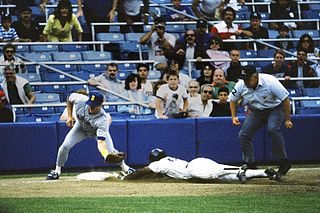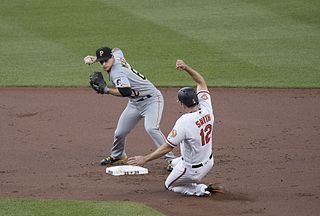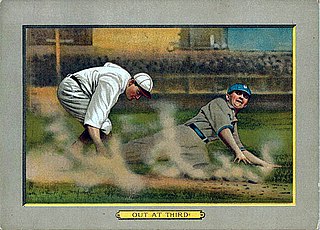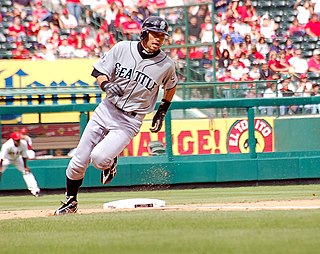Baseball statistics play an important role in evaluating the progress of a player or team.

In baseball, a stolen base occurs when a runner advances to a base to which they are not entitled and the official scorer rules that the advance should be credited to the action of the runner. The umpires determine whether the runner is safe or out at the next base, but the official scorer rules on the question of credit or blame for the advance under Rule 10 of the MLB's Official Rules.
In baseball, fielder's choice refers to a variety of plays involving an offensive player reaching a base due to the defense's attempt to put out another baserunner, or the defensive team's indifference to his advance. Fielder's choice is not called by the umpires on the field of play; rather, it is recorded by the official scorer to account for the offensive player's advance without crediting him with an offensive statistic such as a hit or stolen base.

In baseball and softball, a double play is the act of making two outs during the same continuous play. Double plays can occur any time there is at least one baserunner and fewer than two outs.
In baseball, a triple play is the act of making three outs during the same play. There have only been 733 triple plays in Major League Baseball (MLB) since 1876, an average of just over five per season.

In baseball statistics, an error is an act, in the judgment of the official scorer, of a fielder misplaying a ball in a manner that allows a batter or baserunner to advance one or more bases or allows a plate appearance to continue after the batter should have been put out. The term error is sometimes used to refer to the play during which an error was committed.

In the game of baseball, the official scorer is a person appointed by the league to record the events on the field, and to send the official scoring record of the game back to the league offices. In addition to recording the events on the field such as the outcome of each plate appearance and the circumstances of any baserunner's advance around the bases, the official scorer is also charged with making judgment calls that do not affect the progress or outcome of the game. Judgment calls are primarily made about errors, unearned runs, fielder's choice, the value of hits in certain situations, and wild pitches, all of which are included in the record compiled. This record is used to compile statistics for each player and team. A box score is a summary of the official scorer's game record.

In baseball, an out occurs when the umpire rules a batter or baserunner out. When a batter or runner is out, they lose their ability to score a run and must return to the dugout until their next turn at bat. When three outs are recorded in a half-inning, the batting team's turn expires.
In baseball, to tag up is for a baserunner to retouch or remain on their starting base until (after) the ball is first touched by a fielder. By rule, baserunners must tag up when a hit ball is caught before it bounces by a fielder, and in such situations, are out if any fielder with possession of the ball touches their starting base before they do. After a legal tag up, runners are free to attempt to advance, even if the ball was caught in foul territory. On long fly ball outs, runners can often gain a base; when a runner scores by these means, this is called a sacrifice fly. On short fly balls, runners seldom attempt to advance after tagging up, due to the high risk of being thrown out.

The rules of baseball differ slightly from league to league, but in general share the same basic game play.

In baseball, an assist is a defensive statistic, baseball being one of the few sports in which the defensive team controls the ball. An assist is credited to every defensive player who fields or touches the ball prior to the recording of a putout, even if the contact was unintentional. For example, if a ball strikes a player's leg and bounces off him to another fielder, who tags the baserunner, the first player is credited with an assist. A fielder can receive a maximum of one assist per out recorded. An assist is also credited if a putout would have occurred, had another fielder not committed an error. For example, a shortstop might field a ground ball cleanly, but the first baseman might drop his throw. In this case, an error would be charged to the first baseman, and the shortstop would be credited with an assist.
In baseball, interference occurs in situations in which a person illegally changes the course of play from what is expected. Interference might be committed by players on the offense, players not currently in the game, catchers, umpires, or spectators. Each type of interference is covered differently by the rules.

In baseball, a pickoff is an act by a pitcher or catcher, throwing a live ball to a fielder so that the fielder can tag out a baserunner who is either leading off or about to begin stealing the next base.

In baseball, a rundown, informally known as a pickle or the hotbox, is a situation that occurs when the baserunner is stranded between two bases, also known as no-man's land, and is in jeopardy of being tagged out. When the baserunner attempts to advance to the next base, he is cut off by the defensive player who has a live ball, and attempts to return to his previous base before being tagged out. As he is doing this, the defender throws the ball past the baserunner to the defender at the previous base, forcing the baserunner to reverse directions again. This is repeated until the runner is put out or reaches a base safely.
A hit and run is a high risk, high reward offensive strategy used in baseball. It uses a stolen base attempt to try to place the defending infielders out of position for an attempted base hit.

In baseball, base running is the act of running from base to base, performed by members of the team at bat.










